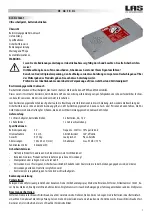
29
400E-Y Deluge Valve
[email protected] • www.bermad.com
The information herein is subject to change without notice. BERMAD shall not be held liable for
any errors. All rights reserved. © Copyright by BERMAD
.
PCSP4E-ADV_24.02.12
I. Trip-test the deluge system via the electric release control panel. The release may be tripped by the
method suggested by the release control panel manufacturer.
J. Trip test the deluge system by decreasing pressure in the pneumatic release system.
K. The manual emergency release handle is to be pulled. The Deluge Valve should open and discharge
water. Observe upstream Pressure Gauge while full flow is on. Inspect all system nozzles.
L. Take all additional measures as required by NFPA-25 "Standard for the Inspection Testing and
Maintenance of Water-Based Fire Protection Systems."
M. Clean the priming strainer prior to resetting the Deluge Valve.
5.2
Abnormal Conditions
5.2.1 Alarm Pressure Switch Fails to Sound
A. Check for obstructions in the alarm test line.
B. Clean the alarm-line strainer (if a water motor alarm is installed).
C. Make certain the alarm is free to operate.
D. Test the electrical circuit to the electric alarm (if utilized).
5.2.2 False Trip
Check for any of the following possible causes:
A. Check and test the electrical circuit to the Solenoid Valve.
B. Check for Malfunctioning EMR device.
5.2.3 Leakage through Deluge Valve
Check for any of the following possible causes:
A. Check for clogged priming strainer
B. Leaking control trim system.
C. Inadequate pneumatic pressure supply.
D. Leaking Dry Pilot release system.
E. Damaged deluge valve internal elastomer or seat.
5.2.4 Deluge Valve Will Not Reset
Check for any of the following possible causes:
C. The Pilot Valve is clogged or not reset properly
D. Inadequate Pneumatic Pressure supply.
E. Check for clogged priming strainer, the screen should be properly cleaned.
F. Closed priming valve.
G. Check for Foreign object lodged between seal and valve seat.
H. Control Panel is not reset. Check for Faulty circuits, using manufacturer instructions.
I. Leak in Dry Pilot Line release system.
J. Clogged orifice assy.
5.2.5 Difficulty in Performance
Where difficulty in performance is experienced, the manufacturer or his authorized representative should be
contacted if any field adjustment is to be made.
















































